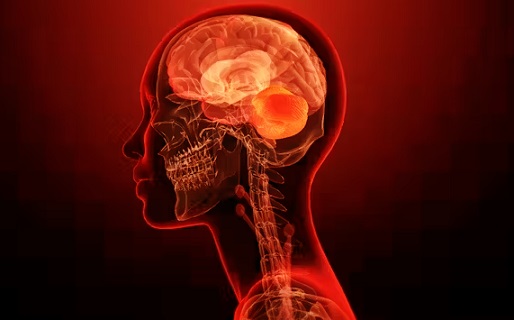Nikhil Prasad Fact checked by:Thailand Medical News Team May 05, 2025 7 months, 2 weeks, 5 days, 6 hours, 50 minutes ago
Medical News: New warning signs in the aging brain revealed by rise of hidden rogue DNA elements
A groundbreaking study from researchers at the Centro de Biología Molecular Severo Ochoa (CSIC/UAM) and Universidad Autónoma de Madrid in Spain has uncovered new clues about how aging affects the brain—highlighting the unexpected role of a mysterious genetic element called LINE-1 and its protein product, ORF1p. These so-called “jumping genes,” once thought to be evolutionary leftovers, appear to awaken as we age and may contribute to brain aging and even neurodegeneration.
 New Study Links Retrotransposon Protein to Brain Aging and Neuroinflammation
New Study Links Retrotransposon Protein to Brain Aging and Neuroinflammation
LINE-1 elements are ancient fragments of DNA that make up nearly 17 percent of the human genome. While most of them are inactive, a small subset retains the ability to copy and paste themselves into new spots in our DNA, potentially disrupting important genetic instructions. This
Medical News report focuses on how one of the key proteins these elements produce—called ORF1p—is increasingly expressed in aging brains and may be linked to harmful inflammation in the central nervous system.
Rogue DNA Elements Stir in Aging Brain
The Spanish research team used a series of fluorescent imaging techniques to detect ORF1p levels in mouse brains at various ages. They found that older mice, especially those aged 18 to 24 months, had much higher levels of this protein compared to younger animals. The entorhinal cortex—a brain region vital for memory—showed the most striking increase in ORF1p levels. Two distinct types of staining patterns were identified: a diffuse pattern in younger brains and a more intense, clustered form in older ones, which the researchers labeled “Type I.” This concentrated form of ORF1p seems to be a potential new biomarker of brain aging.
The study also explored which brain cells were affected. The ORF1p protein was found not only in neurons but also in oligodendrocytes (cells that insulate nerve fibers) and microglia (the brain’s immune cells). Interestingly, it was not found in astrocytes, another major cell type in the brain. This finding hints at a selective mechanism driving LINE-1 activation in specific brain cells.
Microglia and the Inflammatory Link
Perhaps the most striking finding is the relationship between ORF1p and microglial activation. Microglia, which act as the brain's first line of defense, are known to become more reactive with age—a phenomenon linked to neuroinflammatory conditions like Alzheimer’s disease. The researchers found a significant overlap between high ORF1p levels and activated microglia, especially in older mice.
Using specialized markers, they showed that as early as six months of age, mice began showing increased colocalization of ORF1p with activated microglia. This suggests a possible role for ORF1p in triggering or sustaining brain inflammation as we age. In fact, prior studies have already shown th
at heightened LINE-1 activity can stimulate inflammatory responses and disrupt DNA stability.
A Possible Culprit in Neurodegeneration
These findings provide critical support for the "transposon theory of aging," which proposes that age-related breakdowns in genomic regulation allow transposable elements like LINE-1 to become reactivated. When this happens in the brain, the resulting genomic instability and inflammation may contribute to disorders such as Alzheimer’s and other forms of neurodegeneration.
The researchers also referenced recent evidence showing that ORF1p levels are elevated in brain tissues from patients with late-onset Alzheimer’s. In light of this, LINE-1 elements and their protein products could become promising targets for future drugs. For instance, treatments that block LINE-1’s reverse transcriptase activity have already shown early success in reducing brain inflammation in preclinical studies.
Conclusion
This important new study sheds light on how ancient DNA elements embedded within our genomes may awaken as we age, potentially driving harmful changes in the brain. The increased presence of ORF1p in neurons and especially microglia suggests that LINE-1 reactivation may play a direct role in aging-related inflammation and neurodegeneration. Understanding these hidden molecular processes opens the door to identifying new biomarkers for early detection of brain aging and possibly even developing targeted therapies to slow or prevent age-related cognitive decline. More research is urgently needed to validate these findings in humans and assess the long-term safety of drugs targeting retrotransposon activity.
The study findings were published in the peer reviewed: International Journal of Molecular Sciences.
https://www.mdpi.com/1422-0067/26/9/4368
For the latest COVID-19 News, keep on logging to Thailand
Medical News.
Read Also:
https://www.thailandmedical.news/news/must-read-study-proposes-role-of-sars-cov-2-spike-protein,-stem-cells-and-retrotransposons-in-long-covid-syndrome
https://www.thailandmedical.news/news/breaking-long-covid-is-a-misnomer-the-conditions-are-being-caused-by-viral-persistence-and-viral-peptides-similar-to-retrotransposons-and-introns
https://www.thailandmedical.news/news/breaking-medical-news-discovery-of-hidden-viral-proteins-in-ssrna-viruses-opens-a-new-dimension-in-virology-and-is-relevant-for-sars-cov-2
https://www.thailandmedical.news/pages/thailand_doctors_listings
https://www.thailandmedical.news/articles/hospital-news
https://www.thailandmedical.news/articles/anti-aging
